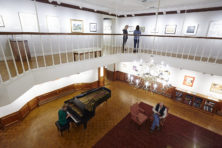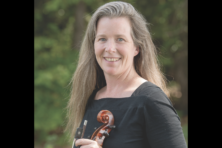Culture Club: Miller Art Museum Hosts Door County through the Eyes of Joseph Friebert and Betsy Ritz Friebert
- Share
- Tweet
- Pin
- Share

by Susan Friebert Rossen
In Door County, one finds both solitude and community. It has long been a destination for visual artists, attracting creators and students in all media to its inspiring scenery, the peaceful remove it offers from the bustle of urban life, and its embrace of the arts.
The region’s reputation as a thriving art colony was greatly enhanced by the founding in 1935 of The Clearing (now The Clearing Folk School), the experimental summer school in Ellison Bay established by the famed landscape architect Jens Jensen. Another boost was provided by Madeline Tourtelot’s Ephraim Art School, started in 1943, and her Door Harbor School of Art, which in 1960 became Peninsula School of Art in Fish Creek. Then in 1975 came the Miller Art Museum, established in part to highlight the achievements of those who immortalize Door County in their art.
Among the artists who frequented Door County were the Milwaukee-based couple Joseph Friebert and Betsy Ritz Friebert. Drawn to The Clearing, they made their first sketching trip to the peninsula in 1937, just after their marriage, and they continued to visit in subsequent decades.

Betsy Ritz Friebert, “Corn Stalks,” pen and ink, 1938. 
Betsy Ritz Friebert, “Man and Boats, Jacksonport,” pen and ink, 1938. 
Betsy Ritz Friebert, “Ephraim,” pen and ink on paper, 1938.
The influence of Door County on their art is evident in paintings and drawings – some still bound in sketchbooks – retained by the family. They demonstrate the key role the county played in shaping the two artists’ individual approaches and their devotion to the landscape of their home state.
Ritz (1910-63) exhibited artistic gifts from childhood. In 1932, she graduated from Milwaukee State Teachers College (now the University of Wisconsin-Milwaukee) with a degree in art education. She was an active participant in Milwaukee’s community of young artists, winning prizes in local juried exhibitions and serving as secretary of the Wisconsin Painters and Sculptors organization.
Ritz organized weekly life-drawing sessions in her studio, charging a quarter per session. One of the attendees was Friebert (1908-2002), a pharmacist who enjoyed drawing.
Encouraged by Ritz and other artists, Friebert entered Milwaukee State Teachers College in 1942 to pursue a career in art, all the while supporting himself and his growing family as a pharmacist. Shortly after graduating in 1945 at age 37, he joined the art faculty and became a much-beloved teacher over the next 30 years.
There were few, if any, role models in Milwaukee during the 1930s and 1940s for women who wanted both a family and a career. Although Ritz focused on her art during her early married years, once she and Friebert had children, they decided that he would be the professional artist, and she would be a wife and mother and support him as an adviser.
Whenever possible, Ritz sketched outdoors and joined Friebert in the studio to draw from a model. She looked forward to having an “empty nest” so that she could devote more time to artmaking and pursuing a long-held dream of becoming an illustrator. Unfortunately, she died from cancer at 52, before she could realize that goal.
The collection of drawings, watercolors, gouaches, paintings and sketchbooks is fascinating on a number of levels. The couple enjoyed depicting the same scenes, drawing en plein air in both Jacksonport and the county’s rural interior, which underscores how distinctive their individual ways of making art were.
Ritz’s works demonstrate her illustrative skills and panache. She delighted in the economy and expressivity of pure line, defining shapes mainly through contour and working primarily in black and white.
Friebert’s approach was, instead, painterly: He built forms through nervous strokes and glowing tonal effects. His palette is dominated by earthy reds, rich browns, pinks and golden hues; his surfaces are layered and complex. He created deeply felt, brooding scenes; she tended toward the light and lyrical. For Ritz, less was more; for Friebert, more was more.

Joseph Friebert, “Lake Michigan Shoreline,” gouache on paper, 1970. 
Joseph Friebert, “Blue Landscape,” gouache on paper, 1966.
The influence that Door County had on their artwork is the subject of the exhibition Door County through the Eyes of Joseph Friebert and Betsy Ritz Friebert, organized by the Miller Art Museum, 107 S. 4th Ave. in Sturgeon Bay. It will be on display through July 15.
Peninsula Arts and Humanities Alliance, which contributes Culture Club, is a coalition of nonprofit organizations whose purpose is to enhance, promote and advocate the arts, humanities and natural sciences in Door County.




